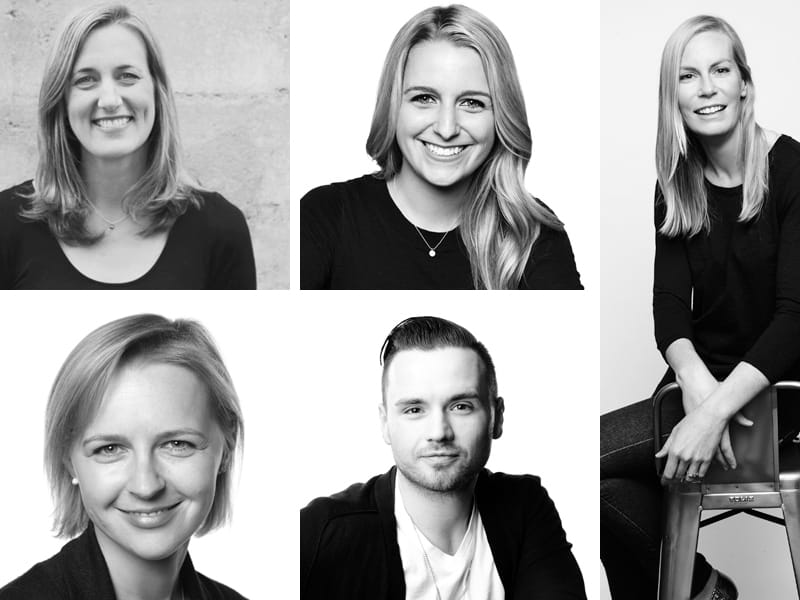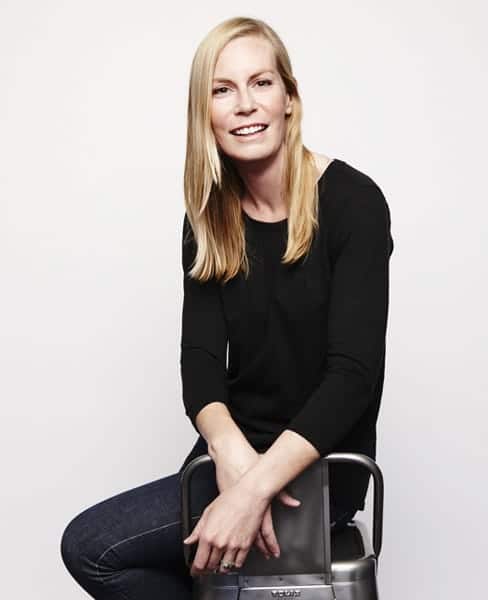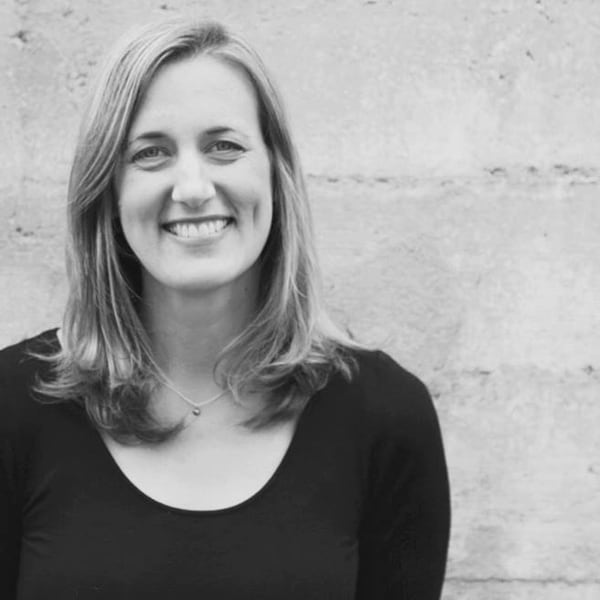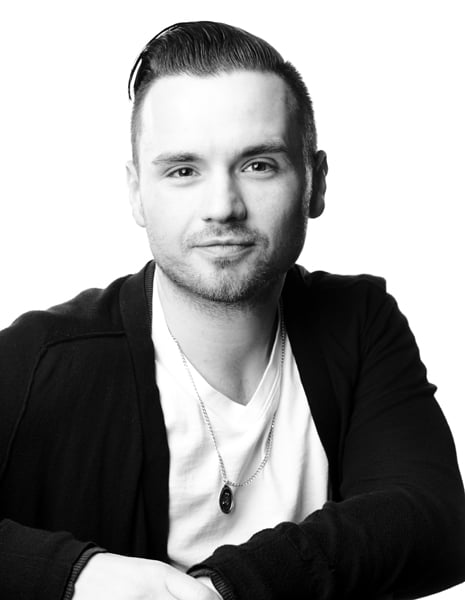It may be the most talked-about design firm on the planet. And IDEO, a design-centered global enterprise regarded as one of the most innovative companies in the world, employs a number of alumni of the School of Graphic Design, helping them get started on their graphic design career.

IDEO applies the power of design thinking to companies, communities, organizations and individuals to help them reach their goals. In its 10 locations around the world, IDEO is itself designed to get the best from its creative workforce.
Here, five Graphic Design graduates talk about how they contribute in their roles at IDEO, what they learned at the Academy that matters to them as professional designers, and what they would say to students of today.
Katie Clark
Katie Clark joined IDEO in 2003, earning her MFA in Graphic Design from the Academy in 2007. She’s now Digital Marketing director, working on IDEO’s external-facing digital sites and platforms, social messaging, and global marketing strategies and projects for IDEO’s 10 locations around the world.
It’s an exciting opportunity, she says, quoting one of IDEO’s founders. “Bill Moggridge used to say, ‘It doesn’t occur to most people that everything is designed.’ Graphic design is usually just the tip of the iceberg in that sense!”
“One of the first classes I took was very much about sensemaking and wayfinding,” she says. “I still think about it to this day, as it very much maps onto what we do every day at IDEO—making sense of complex problems.”
Clark cites Hunter Wimmer, the school’s associate director, as among the faculty members who influenced her. “Hunter was one of my most trusted advisers at the Academy—he’s also a former boss of mine from IDEO. His minimalist style and systemic approach go into everything I do these days…including how I furnish my home. I always wonder, what would Hunter do?
“I was fortunate to already have a job at IDEO when I graduated, but everything I learned at the Academy is applicable to the work I do. I still reach out to the Academy for freelance designers, soon-to-graduate designers, interns. The resources they offer are endless, and I trust that anyone coming out of the program is both talented and ready to work hard.”
She’s up front about what it takes to earn a degree at the Academy.
“It’s a tough program, but it prepares you for the professional world. One of the things I loved so much about the Academy was its relevance. You have real-world designers teaching you, showing you how to approach real-world problems. They have been there. There is no substitute for true professionals showing you the ropes.”
Kristin Riger
Kristin Riger, MFA 2014, is a communication designer at IDEO.org, the nonprofit organization born out of IDEO in 2011. “We focus specifically on design projects that tackle the challenges of poverty in the developing world,” she explains. “I’m on the Communications team at IDEO.org, and we are responsible for storytelling, branding, and communicating and engaging with IDEO.org’s design and learning community.”
She helped produce IDEO.org’s first-ever impact report titled “Impact: A Design Perspective” in her initial year on the job, 2015, and says, “After four years, 64 projects and about a million prototypes, we’re coming to see what it takes for a mission-driven design organization to make real change in the world,” noting that the group is currently involved in a large rebranding and website design project scheduled for launch this year.
Typography was a special area of emphasis for Riger at the Academy. “Every one of my typography classes at the Academy was inspiring and eye-opening,” she says. “We built a foundation for appreciating typography early on in the program, and in each class, I appreciated the level of detail in which my eye was trained for choosing the right typefaces. We learned a wide range of ways to use type to express an idea, understanding when classic typography is the right choice, and when it’s time to go crazy and experiment. In these classes, I appreciated the balance of attention to detail, balanced with encouragement to go nuts and break the rules when it’s appropriate.”
Typography courses and her Nature of Identity class were invaluable for her work at IDEO.org, she says. “Nature of Identity was particularly helpful in preparing me for how the design process works during an actual rebranding project. Many of the exercises we did to uncover the soul of the brand we chose in that class are the same as those we have used at IDEO.org for our rebranding projects. The class was also an excellent exercise in systems design, which is such an important aspect of almost every project I have ever worked on in the past year.”
That branding class, taught by Wimmer, was an important milestone. “I gained a lot of confidence in my abilities through Hunter’s leadership and classes, and I always felt he had my best interests at heart. That experience also taught me how important mentorship is in your career. Seeing him push students to be the best designers that they can be inspired me to want to serve in that mentorship role for junior designers and help them grow.”
Studying graphic design has changed how she sees the world. “I appreciate beauty in the smallest of everyday objects. I notice patterns, compositions and color in nature and my surroundings in ways I hadn’t before. I approach problem solving in a completely different way and appreciate the process so much more. Graphic designers are trained to have a different perspective, and I’ve enjoyed honing that skill—to see things in new ways and reimagine the way things currently are.
When it comes to giving advice to current students, Riger veers to the practical. “Get enough sleep! I learned towards the end of my time at the Academy that getting enough sleep makes you a significantly better, and more reasonable, designer. Giving yourself the space to take care of yourself will make your work better and prepare you for life outside of grad school. So sleep. Trust me on this one.”
Alana Ippolito
Alana Ippolito is a 2011 MFA graduate of the Academy who until recently was a designer and marketing lead at IDEO. “I worked with the IDEO Marketing and IDEO U teams,” she reports. “IDEO U is the new online school that launched in 2015, for which I designed the brand mark and overall aesthetic…and I also provided design support for that venture.”
IDEO U is a unique online learning experience that helps users leverage the power of design thinking and solve problems in new ways.
“In a nutshell, I’ve been a visual storyteller for IDEO—I took our great stories and curated and sometimes created imagery that supports them. I also did internal and external design projects for Marketing and helped support the IDEO brand through various efforts.”
Ippolito is one of the Academy students who juggled working for IDEO while earning her MBA at the Academy. Although she’s now devoting to the subject of her thesis project, “ZigZag City Guides,” and is no longer with the firm, she has rewarding memories of her involvement. “Before I left, I was managing an internal marketing project that highlights the strongest IDEO stories from around the globe, as well as the visuals for IDEO U’s third course, titled ‘Storytelling for Influence.’”
Like the other graduates now working for IDEO, Ippolito says her thesis class, Visual Communications Lab, and the resulting project provided the best possible preparation for employment as a professional designer. ZigZag City Guides is a lively and absorbing package of materials that help prepare young people to visit major cities around the world. “The guides are sold in dozens of retail stores as well as on our website,” she says.
“Since I was working at IDEO while in school, everything I learned in both settings complemented each other. This helped me learn what it takes to go from a very vague idea to a finished product.”
Now that’s she’s graduated, Ippolito has three pieces of advice for current students. “First, get as much feedback as possible for all projects and from a variety of people, and learn to synthesize that information so you can make the appropriate edits. Second, prototype! Test your ideas out in the real world as early as possible. And third, approach your thesis project as if you’re starting a business that’s solving a problem in the market. This will help you approach your thesis differently than a typical school project.”
Molly Rolig
Molly Rolig, now a communication designer at IDEO, earned her BFA in 2011 and joined the company in 2013. “I work in our Food Studio, which focuses on food and beverage clients exclusively,” she says.
She credits her preparation at the Academy, especially packaging classes, for allowing her to make a professional contribution to the work. “Being responsible for the overall form, as well as for graphics, and creating holistic stories around projects were particularly valuable,” she says. She singles out Packaging 4, which emphasizes group projects: “It prepared us for working as a team, with the project management that goes into that, as well as building out brands in a more robust way.”
Instructor Michael Osborne, a nationally renowned packaging designer, was a draw for her when she chose the Academy. “I went into the Graphic Design program looking forward to Packaging 4 and having Michael Osborne, my favorite designer, as an instructor. His class proved to be just as inspiring, fulfilling and challenging as I had hoped—and then some!”
Rolig interned for Osborne at his firm, Michael Osborne Design in San Francisco, her senior year. “I consider him to be one of my biggest mentors of my career,” she says, “and Tom McNulty, Hunter Wimmer and Christine George all stand out as huge influencers on my education, too.” She highly values the opportunity to be among the students who presented their work at the packaging conference held by The Dieline.com, a major global packaging site.
“Interning with Michael Osborne paved the way for my interest in focusing on package design,” she recalls. “My first job after graduation was with Williams-Sonoma. I was invited to interview while showing my portfolio at the Academy Winter Show. After that, I went to CF Napa, where the design director, Kevin Reeves, is an Academy graduate. While my connections to the Academy weren’t directly a part of getting a job at IDEO, they certainly built the foundation.”
Rolig references the intensive, personal teaching style at the Graphic Design School when offering advice for current students. “Pay attention to the value of critiques,” she says, “particularly the harsh ones! Learning how to take that information and learn and grow from it is a huge skill. Understand that the instructors pushing your work aren’t ‘out to get you’—they are the ones helping you the most.”
Anthony Stimola
Anthony Stimola earned his MFA in 2012 and joined IDEO in 2014. He is currently a communication designer in IDEO’s Design for Change studio in San Francisco. The studio, he says, frequently interfaces with clients in the realm of leadership and strategy.
“The Design for Change group tends to work more in the consulting realm in areas such as organizational design, so I’m involved with business leaders. As a designer in the group, I take their input and develop materials that push their brand and culture.”
Those materials run the gamut from print to video, digital platforms and exhibits. “It’s never the same thing twice, I can tell you that much,” says Stimola.
What’s it like to work at IDEO?
“It’s inspiring, at times intimidating…but those moments are short-lived, because everyone at IDEO is extremely supportive. Design is a very rigorous process here, so once you’re part of the group, everyone has a strong interest in you succeeding. People seek out the right mentors for you and bring the right people to the table…so you end up working with a cross-disciplinary team. You’re going to get your hands into designing for many different platforms.”
“We have a very thoughtful way of looking at client culture. You have a blend of empathy and something that’s almost anthropological—you’re looking at another culture.”
Stimola says his experiences at the Academy helped develop the perspective necessary to solve clients’ problems with discipline and clarity. Of particular value was his thesis class, Visual Communications Lab; his thesis, titled “Urbanis,” was the outcome.
“The level of rigor and ambiguity in the thesis process prepared me for my career and IDEO—knowing you have to do this big thing, not knowing what it is at first, but that you have to figure it out.” Initially, he says, he felt lost in the moment. But his instructors—Phil Hamlett, Hunter Wimmer and Jeremy Stout—kept pushing him.
“Hunter was one of the instructors who pushed me from start to finish. Early on, I had a meeting with him. We had a very honest, candid conversation. He told me to change my perspective and work outside my comfort zone, and it resonated with me. I think he saw me as someone who had some raw talent but hadn’t zeroed in on what I wanted to do.
“In the middle of the program, I would have said, ‘This is hell.’ Looking back, it was really valuable to work with individuals like Hunter, Phil, Mary [Scott, chair of the school] and many other talented people. They helped me gain the discipline to come out a stronger designer.”
Stimola had a varied background before enrolling in the Graphic Design graduate program. He’s glad he made the choice.
“The way I saw it, at the end of the day graphic design would teach me to have an eye for refined design. I do enjoy process; I enjoy making things. What the MFA program at the Academy does is teach you there’s more to design than making beautiful things. The program teaches you to have a point of view, to build rigor into your work, to have a love for your craft, and ultimately to create strong ideas—a deeper sense of purpose and thinking.”




